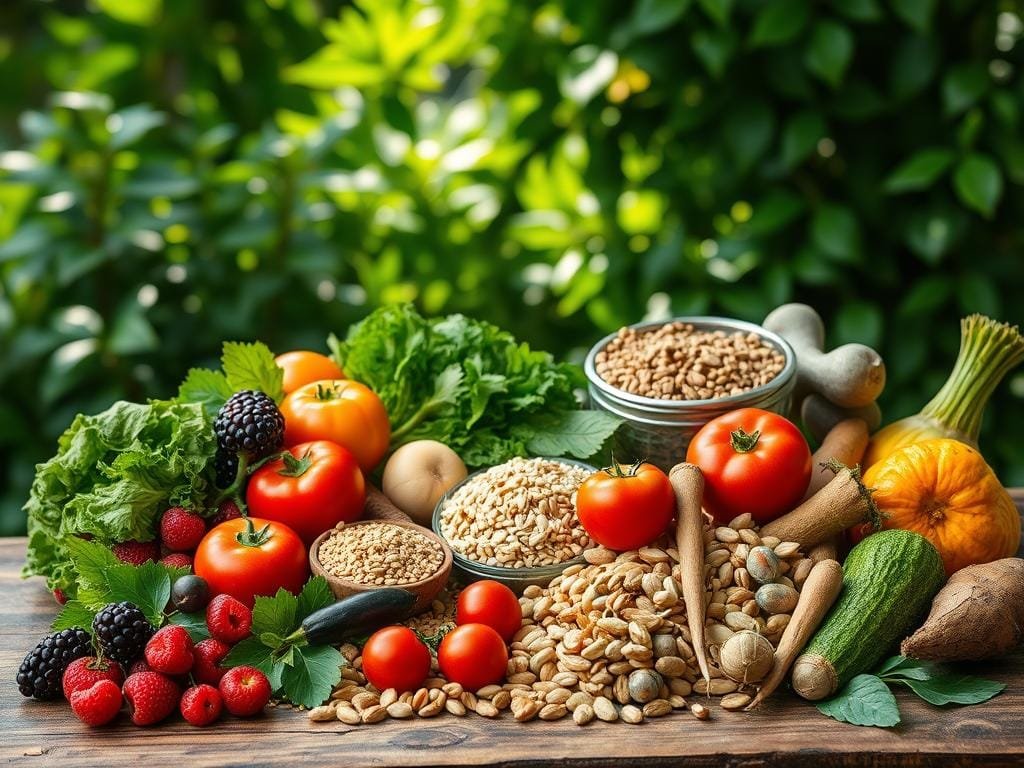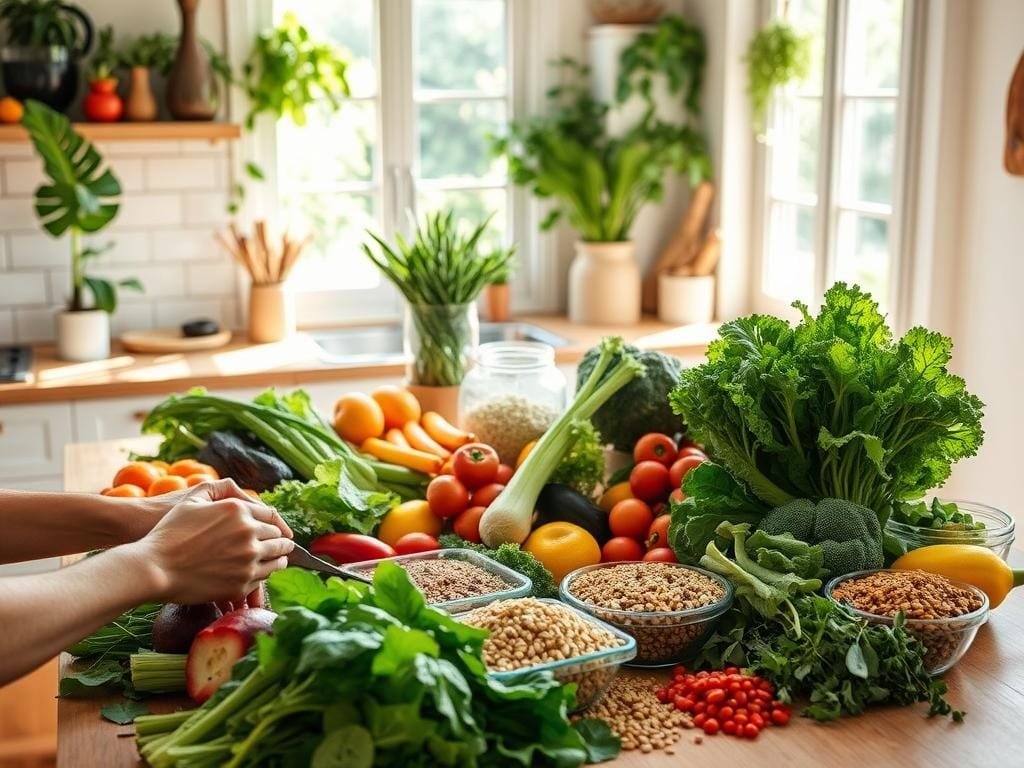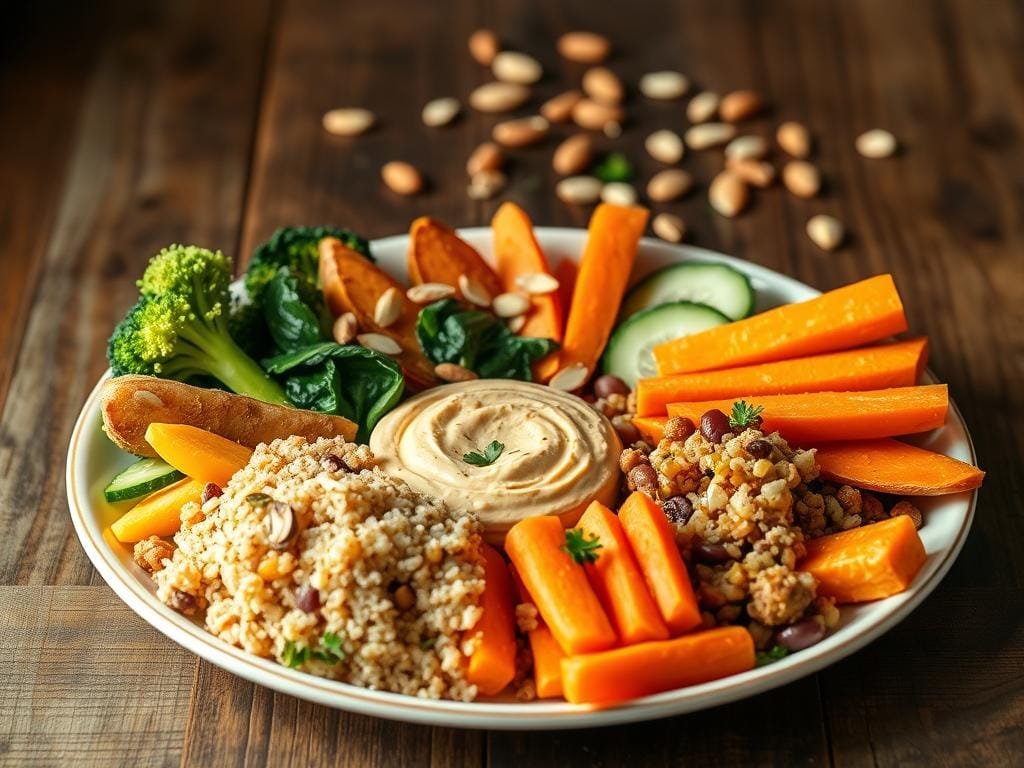Did you know that a vegetarian or vegan diet can really boost your health? More and more people are choosing to eat this way because of the plant-based nutrition benefits.
Adding more plant-based meals to your diet can do wonders. It’s good for your heart and helps the planet too. You’ll find lots of tasty, healthy options in vegetarian and vegan food.
Table of Contents
Key Takeaways
- Adopting a vegetarian or vegan diet can improve overall health and wellbeing.
- Plant-based nutrition offers numerous benefits, including improved heart health.
- A vegan diet can help reduce environmental footprint.
- Vegetarian and vegan lifestyles are becoming increasingly popular.
- Incorporating plant-powered meals can enhance overall health.
Understanding Plant-Based Diets: Definitions and Distinctions
Plant-based diets are becoming more popular. But what do terms like “vegetarian” and “vegan” mean? Knowing the different diets is key to making choices that fit your lifestyle and taste.
What is a Vegetarian Diet?
A vegetarian diet doesn’t include meat, fish, or poultry. But, there are many types of vegetarian diets. Each has its own rules about what you can and can’t eat.
- Lacto-ovo-vegetarian: Doesn’t include meat, fish, or poultry but allows dairy and eggs.
- Lacto-vegetarian: Doesn’t include eggs, meat, fish, or poultry.
- Ovo-vegetarian: Includes eggs but not dairy or any meat.
- Pescatarian: Not strictly vegetarian, but includes fish and seafood while excluding meat and poultry.
What is a Vegan Diet?
A vegan diet goes further by avoiding all animal products. This means no dairy, eggs, or even honey. Vegans also avoid products made from animals and tested on animals.
The vegan diet focuses on fruits, vegetables, legumes, and whole grains. It needs careful planning to get enough nutrients from plant sources.
Other Plant-Forward Approaches
There are other plant-forward diets too. They focus on plant-based foods but don’t exclude animal products completely.
| Diet | Description |
|---|---|
| Flexitarian | Primarily vegetarian but occasionally includes meat or fish. |
| Plant-based | Emphasizes foods from plants but may include some animal products. |
| Raw Food Diet | Focuses on uncooked and unprocessed plant foods. |
Knowing these definitions helps you pick a diet that fits your health goals, values, and taste.
The Rise of Plant-Powered Diet in America
The way Americans eat is changing, moving towards plant-based diets. This shift is good for health and the planet. It’s important to know the numbers and cultural changes behind this trend.
Current Statistics and Trends
More people in America are choosing plant-based diets. Here are some recent numbers:
| Category | 2018 | 2022 | Change |
|---|---|---|---|
| Vegan Population | 1.5 million | 3.1 million | +106% |
| Vegetarian Population | 7.3 million | 9.5 million | +30% |
| Plant-Based Meat Market | $1.4 billion | $4.6 billion | +229% |
These numbers show a big change towards eating plants. People are doing this for health, the planet, and animal rights.
Cultural Shifts Towards Plant-Based Living
America’s culture is evolving, with more people living plant-based. You might see:
- More plant-based choices in restaurants and stores
- More plant-based diet talk on social media and from famous people
- More events and groups for those who eat plants, making them feel part of a community
By choosing plant-based eating, you join a big cultural shift. It’s towards a sustainable and kinder lifestyle. The trend is clear: eating plants is becoming more common.
Health Benefits of Vegetarian and Vegan Eating
A well-planned vegetarian or vegan diet offers many health benefits. It can lower the risk of chronic diseases and boost energy levels. By eating more plant-based foods, people can see big health improvements.
Reduced Risk of Chronic Diseases
Vegetarian and vegan diets can lower the risk of heart disease, diabetes, and some cancers. This is because they are full of fruits, vegetables, and whole grains. These foods are packed with antioxidants, fiber, and other nutrients that are good for you.
- Heart Health: Eating less saturated fat and more fiber helps your heart stay healthy.
- Cancer Prevention: Eating lots of fruits and vegetables can lower your risk of some cancers.
- Diabetes Management: Plant-based diets can improve insulin sensitivity and lower the risk of type 2 diabetes.
Weight Management Advantages
Vegetarian and vegan diets are often lower in calories and higher in fiber. This makes it easier to keep a healthy weight. By eating a variety of plant-based foods, you can lose weight and keep it off.
- More fiber helps you feel full and eat fewer calories.
- Plant-based foods are lower in calories, which helps with weight management.
Improved Digestive Health
A diet rich in fiber from fruits, vegetables, and whole grains helps with digestion. It can prevent constipation. A healthy digestive system is key to overall health and well-being.
For more information on vegan and vegetarian eating, you can visit Utah State University Extension.
Enhanced Energy and Vitality
Vegetarian and vegan diets are often linked to more energy and a sense of vitality. This is because they are full of nutrient-dense foods. They also avoid processed and high-sugar foods.
Environmental Impact of Plant-Based Eating
Plant-based diets are a strong tool against climate change and environmental harm. By picking plant-based foods, you can greatly lessen your impact on the planet.
Reducing Carbon Footprint
Animal farming is a big source of greenhouse gas emissions, making up about 14.5% of global emissions. On the other hand, plant-based diets have a smaller carbon footprint. Switching to a plant-based diet can cut your carbon emissions by up to 50%. This is because plants need less energy to grow than animal products and take in carbon dioxide.

Water Conservation Benefits
Water is very valuable, and farming uses a lot of it. Animal farming uses much more water than growing plants. For instance, it takes over 1,000 gallons of water to make just one pound of beef, but only 25 gallons for one pound of wheat. Choosing plant-based foods helps save water and eases the pressure on this essential resource.
Land Use Efficiency
Land use is key to environmental health. Animal farming often leads to deforestation, as forests are cut down for grazing and feed crops. But, plant-based diets need less land, helping to keep natural habitats and biodiversity intact. Going plant-based can ease the demand on land, leading to more efficient use and protecting ecosystems.
By choosing plant-based eating, you’re not just getting healthier. You’re also helping the planet for the future. The green benefits of plant-based diets are obvious, making it a smart choice for those wanting to make a difference.
Ethical Considerations of Plant-Based Diets
Many people choose plant-based diets for ethical reasons. They care about animal treatment and social justice. Learning about these issues can make your commitment stronger and guide your choices.
Animal Welfare Perspectives
Animal welfare is a big reason for choosing plant-based diets. Factory farming is often cruel, focusing on cheap food over animal care. By eating plants, you support kinder farming.
Key Issues in Animal Agriculture:
- Confinement and lack of natural environments
- Antibiotics and hormones for growth
- Inhumane slaughter
Think about how your food choices affect animals. Look into groups that help animals, like those working for ethical food systems.
Social Justice Connections
Plant-based diets also touch on social justice. Food production affects communities, like labor rights and access to healthy food.
| Aspect | Conventional Agriculture | Plant-Based Diets |
|---|---|---|
| Labor Practices | Often involves migrant worker exploitation | Supports fair labor through local and fair-trade |
| Community Impact | Can harm local farmers and communities | Helps local economies with locally grown food |
| Food Access | Leads to health issues in poor areas | Makes healthy food more accessible |
Choosing plant-based diets benefits your health and the planet. It also helps create a fairer food system. As you follow a plant-based path, think about how your choices help others.
Essential Nutrition in Plant-Powered Eating
To get the most from a plant-based diet, focus on essential nutrition. A good vegetarian or vegan diet needs both macronutrients and micronutrients.
Meeting Macronutrient Needs
Macronutrients give us energy and help us grow. On a plant-based diet, make sure you get enough carbs, protein, and healthy fats.
- Carbohydrates: Eat whole grains, fruits, and veggies.
- Protein: Try legumes, nuts, seeds, and whole grains.
- Healthy Fats: Avocados, nuts, seeds, and olive oil are great.
A balanced plant-based diet can meet your macronutrient needs. The trick is to eat a variety of foods.
Critical Micronutrients for Vegetarians and Vegans
Even though plant-based diets are rich in many nutrients, some need extra attention.
| Micronutrient | Importance | Plant-Based Sources |
|---|---|---|
| Vitamin B12 | Crucial for nerve function and red blood cell formation | Fortified plant milk, nutritional yeast, cereals |
| Iron | Essential for healthy red blood cells | Legumes, dark leafy greens, fortified cereals |
| Omega-3 Fatty Acids | Important for heart health and brain function | Algal oil, flaxseeds, chia seeds, walnuts |
Getting enough of these micronutrients is key for good health.
Supplements to Consider
While a good diet is best, supplements can help fill gaps.
- Vitamin B12 supplements for vegans
- Omega-3 supplements from algal oil
- Vitamin D supplements, for those with limited sun or in winter
Always talk to a healthcare professional before starting any supplements.

Plant Protein: Sources and Combinations
Plant protein is more than a trend; it’s a nutritious way to fuel your body. It’s key for a balanced and healthy lifestyle, whether you follow a vegetarian or vegan diet. Knowing the different plant protein sources is essential.
Complete vs. Incomplete Proteins
Proteins are classified as complete or incomplete based on their amino acid profiles. Complete proteins have all nine essential amino acids your body can’t make. Many plant-based foods lack these amino acids, but you can get them all by eating a variety of foods throughout the day.
For example, grains lack lysine, while legumes lack methionine. Pairing whole grains with legumes ensures you get all the essential amino acids your body needs.
Legumes, Nuts, and Seeds
Legumes, nuts, and seeds are rich in plant protein. Legumes, like beans and lentils, are not only high in protein but also in fiber and vitamins. Nuts and seeds, such as almonds and chia seeds, add crunch and protein to your diet.
- Legumes: lentils, chickpeas, black beans
- Nuts: almonds, walnuts, pecans
- Seeds: chia seeds, hemp seeds, pumpkin seeds
Plant-Based Meat Alternatives
Plant-based meat alternatives have become popular. They offer a convenient way to increase protein without animal products. Made from pea, rice, and soy proteins, they can be used in many dishes.
When picking plant-based meat alternatives, choose products high in protein but low in sodium and without artificial additives.
Protein-Rich Meal Ideas
Creating protein-rich meals on a plant-based diet is easy. Here are some ideas:
- Lentil soup with whole grain bread
- Quinoa salad with chickpeas, nuts, and seeds
- Stir-fry with tofu, mixed vegetables, and brown rice
- Chia seed pudding with almond milk and fruit
By adding these protein-rich foods and meal ideas to your diet, you can meet your protein needs. Enjoy the benefits of a plant-powered lifestyle.
Transitioning to a Plant-Based Diet: A Step-by-Step Guide
Starting a plant-based diet can be both thrilling and daunting. But with a good guide, you can make this journey easier. You might be drawn to it for health, environmental, or ethical reasons. Changing to a plant-based diet is a big step that needs careful planning.
Gradual vs. Immediate Approaches
You can pick between a gradual or immediate switch to a plant-based diet. A gradual approach means slowly adding more plant-based meals. You replace animal products gradually. This method is less stressful and more doable for many.
An immediate approach means switching fully to a plant-based diet right away. It’s tougher but rewarding for those who are very committed.
First Steps for Beginners
For newbies, starting with small changes can make a big impact. Start by adding more fruits and veggies to your meals. Try plant-based proteins like legumes, nuts, and seeds. Begin by replacing one or two meals a day with plant-based options.

Overcoming Common Challenges
Switching to a plant-based diet can face challenges like ensuring you get enough nutrients or dealing with social pressures. Learning about plant-based nutrition and meal planning is key. Reading a study on plant-based diets, like this one, can offer helpful insights.
Building a Supportive Community
Having a supportive group makes the transition easier. Look for online forums, join plant-based cooking classes, or find friends with similar diets. They can offer encouragement and useful advice.
| Transition Approach | Pros | Cons |
|---|---|---|
| Gradual | Less overwhelming, more sustainable | Slower progress |
| Immediate | Quick results, high motivation | More challenging, possible nutrient deficiencies if not planned well |
Stocking Your Plant-Powered Kitchen
Having a well-organized kitchen is key for easy plant-based cooking. As you start eating more plants, choose your kitchen items wisely. This helps support your new diet.
Pantry Essentials
A good pantry is the heart of a plant-powered kitchen. Start with grains like brown rice, quinoa, and whole wheat pasta. Canned goods like black beans, chickpeas, and diced tomatoes are great for many dishes.
Also, add spices and herbs to bring out the flavors in your meals.
- Whole grains (brown rice, quinoa, whole wheat pasta)
- Canned goods (black beans, chickpeas, diced tomatoes)
- Nuts and seeds (almonds, chia seeds, flaxseeds)
- Dried fruits and vegetables
- Spices and herbs
Refrigerator and Freezer Staples
Your fridge and freezer should have lots of fresh produce. Include leafy greens, berries, and seasonal fruits and veggies. Also, get plant-based milk and yogurt.
For the freezer, have frozen fruits and veggies. Plus, keep tofu and tempeh for protein.
- Fresh produce (leafy greens, berries, seasonal fruits and vegetables)
- Plant-based milk alternatives and yogurt
- Tofu and tempeh
- Frozen fruits and vegetables
Essential Tools and Equipment
The right tools and equipment make cooking easier. Get a good blender, food processor, and various pots and pans. A sharp knife and cutting board are also must-haves.
- Blender
- Food processor
- Pots and pans
- Knife and cutting board
Stocking your kitchen with these essentials will help you cook tasty, plant-based meals easily.
Meal Planning for Plant-Based Success
To do well on a plant-based diet, you need to get good at meal planning. It helps you eat well, saves time, and cuts down on food waste. Spend a few hours each week planning your meals. This way, you’ll get all the nutrients you need and enjoy tasty plant-based dishes.
Weekly Meal Prep Strategies
Weekly meal prep is a big help for those eating plant-based. It means setting aside time to prepare meals for the next few days. This helps you stay on track and avoid unhealthy choices. Start by using seasonal produce to keep things interesting and save money.
For more ideas on meal prep, check out meal prep ideas for weight loss and muscle. They have lots of tips on making healthy, plant-based meals.
Balanced Plate Formula
It’s important to make a balanced plate to get all the nutrients. Fill half your plate with veggies, a quarter with protein, and a quarter with whole grains. This mix gives you all the vitamins and nutrients you need.

Budget-Friendly Shopping Tips
Eating plant-based doesn’t have to cost a lot. Buy in bulk, choose seasonal produce, and plan meals around sales. Also, shop at local farmers’ markets or use cashback apps to save money.
| Budget-Friendly Tip | Description | Potential Savings |
|---|---|---|
| Buy in Bulk | Purchasing grains, nuts, and dried fruits in bulk reduces packaging waste and saves money. | Up to 30% savings |
| Seasonal Produce | Buying produce in season is cheaper and ensures freshness. | Up to 20% savings |
| Meal Planning | Planning meals around sales and discounts reduces food waste. | Up to 15% savings |
Time-Saving Cooking Techniques
Cooking plant-based meals can be fast and easy with the right methods. Try batch cooking, one-pot meals, and slow cooking. Also, prep ingredients ahead of time to make cooking quicker.
By using these meal planning tips, you’ll save time and money. You’ll also eat a more balanced and healthy diet.
Debunking Common Myths About Vegetarian and Vegan Diets
Vegetarian and vegan diets are often misunderstood. It’s time to clear up these myths with facts. Exploring plant-based eating reveals several myths that can be debunked with evidence.
The Protein Misconception
Many think vegetarian and vegan diets lack protein. But, with some planning, you can easily get enough protein. Legumes, nuts, and seeds are great sources of protein. For example, a cup of cooked lentils has about 18g of protein, and a cup of almonds has around 6g.
The Academy of Nutrition and Dietetics says, “vegetarian and vegan diets can be nutritionally adequate and provide numerous health benefits when appropriately planned.”
“It’s not just about getting enough protein; it’s about getting a balanced mix of nutrients,” says Dr. Amy Lanou, a nutrition expert.
Addressing Nutrient Deficiency Concerns
Some believe vegetarian and vegan diets lack essential nutrients. While it’s true that some nutrients are less common in plant-based foods, a well-planned diet can provide all you need. For example, vitamin B12, often found in animal products, is also in fortified plant milk and cereals.
- Vitamin B12: Found in fortified plant milk and cereals
- Iron: Abundant in legumes, dark leafy greens, and fortified cereals
- Calcium: Available in fortified plant milk, dark leafy greens, and tofu
Cost and Convenience Myths
Some think vegetarian and vegan diets are too pricey or hard to follow. But, with a little planning, it can be both affordable and easy. Buying in bulk, planning meals around seasonal produce, and cooking at home can help save money.
Athletic Performance on Plant-Based Diets
Many believe vegetarian and vegan diets can’t support athletic performance. But, many athletes have succeeded on plant-based diets. Plant-based diets are rich in complex carbohydrates, providing sustained energy for long activities.
Ultramarathon runner Scott Jurek says, “A well-planned vegan diet can provide all the necessary fuel for optimal performance.” By focusing on whole, nutrient-dense foods, athletes can do well on a plant-based diet.
Conclusion: Embracing Your Plant-Powered Journey
Exploring vegetarian and vegan diets shows their many benefits. They improve your health, help the planet, and protect animals. Starting a plant-powered journey can greatly enhance your life.
Learning about vegetarian and vegan diets is a big step. It opens the door to a healthier, more sustainable lifestyle. You’ll find new flavors and nutrients that boost your energy and health.
Starting or continuing your plant-powered journey is important. Adding more plant-based meals helps the environment and animals. Use the tips and resources from this article to keep up your vegan and plant-based eating.

